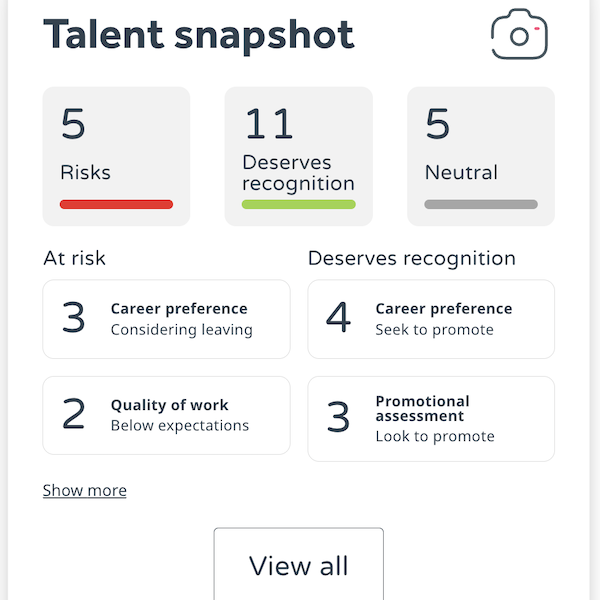It’s a term that gets thrown around a lot, but exactly what is employee engagement? Interestingly, we’ve never really managed to reach a consensus on the exact definition of employee engagement. But as a culture, we spend an enormous amount of time, effort and money chasing something that we really ought to define.
While the definition of employee engagement may vary according to who you ask, it really boils down to creating an environment in which your people can thrive. This can manifest in a number of ways, but truly engaged employees share common experiences. For example, by building a connection to the organisation and to others, by feeling confident and supported, and feeling equipped to do their job well.
Our expert psychologists have identified the 16 areas that need to be fulfilled in order to create an engaged workforce.
Levels of employee engagement
There are of course, levels of employee engagement. Your people need to have their needs met across a range of criteria in order to feel engaged. Simply expressing gratitude towards your employees and praising their work won’t encourage engagement unless it’s supported by other actions.
For example, do they also have a meaning and purpose at the organisation? Do they also feel secure in their role? Once these levels of employee engagement begin to add up, you’ll see motivation, productivity and wellbeing soar.
Our expert psychologists have identified the 16 core levels of employee engagement that need to be fulfilled in order to create an engaged workforce.
What are the benefits?
Employee engagement is often thought of as a fluffy “nice-to-have”. But the UK economy loses a whopping £340 billion each year to disengaged employees. Absenteeism, lost productivity, poor wellbeing and high turnover are all symptoms of disengaged employees – and the financial impact can be enormous for your business.
Investing in your people provides a valuable ROI. Engagement goes hand in hand with high employee retention, productivity, employee loyalty to the organisation and wellbeing. Studies show that engaged employees are 17% more productive than their peers and are 21% more profitable than their peers.
As Steve Jobs once said “The only way to do great work is to love what you do.”
What isn’t employee engagement?
Many organisations have made attempts at engaging employees only to find that it hasn’t worked as planned. Often, this is because they aren’t getting to the root cause of disengagement. Employees aren’t disengaged because they don’t have a free gym pass, but because their underlying needs aren’t being met.
- Employee engagement ≠ coffee and fruit
- Employee engagement ≠ free yoga classes
- Employee engagement ≠ satisfaction
Benefits can be thought of as a quick fix for improving engagement, wellbeing and productivity. But how many employees are actually more committed to their jobs because their employer sent them a fruit and snacks hamper?
Perks, incentives and symbolic gestures aren’t enough to sustain engagement. Employers must cultivate and maintain a healthy environment of trust, support and connection – especially in a hybrid working world.
True engagement comes from meeting the underlying needs of your workforce, and giving managers and employees the tools they need to understand, develop and thrive. So save the cycle to work schemes and dress-down Fridays and instead focus on meeting your people’s deeper needs.
How to drive employee engagement

Grab yourself a copy of The guide to employee engagement: For happy and productive people.
Onboarding
Review your processes from the very beginning. What is the onboarding experience like for new starters? When we start somewhere new, it is beneficial for everyone to have clear expectations set. If things don’t go as planned, or as anticipated then employees can begin to feel negatively about your organisation.
Line managers with the skills to drive engagement
Are your line managers effective at engaging their teams? Most line managers end up in their role because they were good at their previous job – not necessarily because they are effective leaders or inspire and engage.
That’s not to say they can’t. With the right tools and training any line manager can become an effective leader and drive employee engagement in their team.
Better communication across the organisation
Is everyone on the same page? It’s much harder for us to feel engaged and dedicated to our company when we feel like we’re pulling in a different direction to the people around us. Keep everyone in your business aware of your goals and set expectations.
It can be as simple as a monthly webinar or company newsletter to remind staff that they are valued and to improve engagement.
Showing gratitude
“Thank you” can be a huge driver of employee engagement – and the best part is it’s absolutely free. Gratitude can actually be a better motivator than money and a small gesture that makes a big difference.
Are your managers thanking their teams for a job well done?
Regular feedback
Managers must listen to their team in order to improve employee engagement. But understanding what is blocking your people from performing is essential to change.
Having intelligent, constructive conversations are key to improving employee engagement. However, this is an ongoing process, and must become embedded within the culture of your organisation.
How do I create a culture of employee engagement?
As mentioned above, continuous listening to your people is the key to creating a culture of employee engagement. However, it’s not always as simple as just asking your employees what they want. Many of our needs are subconscious.
For example, you might feel somewhat disconnected from your team, but would you be able to articulate that a change of atmosphere would make it easier to develop friendships or team spirit?
These underlying issues can be teased out and resolved in a matter of days with a structured, data-focused employee engagement survey. WeThrive asks every employee 16 questions from the key areas that need to be fulfilled to create an engaged workforce. Then the dynamic survey digs deeper into low scoring areas to determine exactly what they need.
Once your survey closes, managers get instant feedback in the form of action plans to start resolving blockers to engagement within their teams. Recommendations are supported by curated learning content to guide managers and employers to create a culture of employee engagement.
Sign up now and get 10 users free or try the survey yourself.
Designing a long-term employee engagement strategy
A well considered employee engagement strategy will naturally create a people-first culture. This means your employees must be included, and accountable in every stage of the process.
Designing your employee engagement strategy with your people as active participants not only allows managers and HR teams to work on the “bigger picture”, but it is a direct motivator and driver of engagement.

Empowered employees who are in control of their personal growth and set their own goals experience frequent powerful wins. Increased personal accountability fosters long-term motivation, productivity and happiness for both managers and employees.
74% of employees don’t believe they are reaching their full potential, which means most organisations are failing to provide their people with the resources they need to thrive. But how can employees identify exactly which areas they need to grow?
Individual surveys allow employees to take a first-person look at the engagement vulnerabilities and blockers in their work experience. WeThrive Bubbles provide a personal space for each individual employee to survey themselves, instantly view their own results and get specific feedback to improve their engagement.
This makes it easier than ever for individuals to uncover where their personal and professional development goals lie. Backed up with curated learning content and the ability for organisations to link their own L&D content to feedback, your people can easily work on their development goals.
Interested in learning more? Try the individual survey with our 2 minute Bubble demo or sign up today and get 10 Bubbles free!


